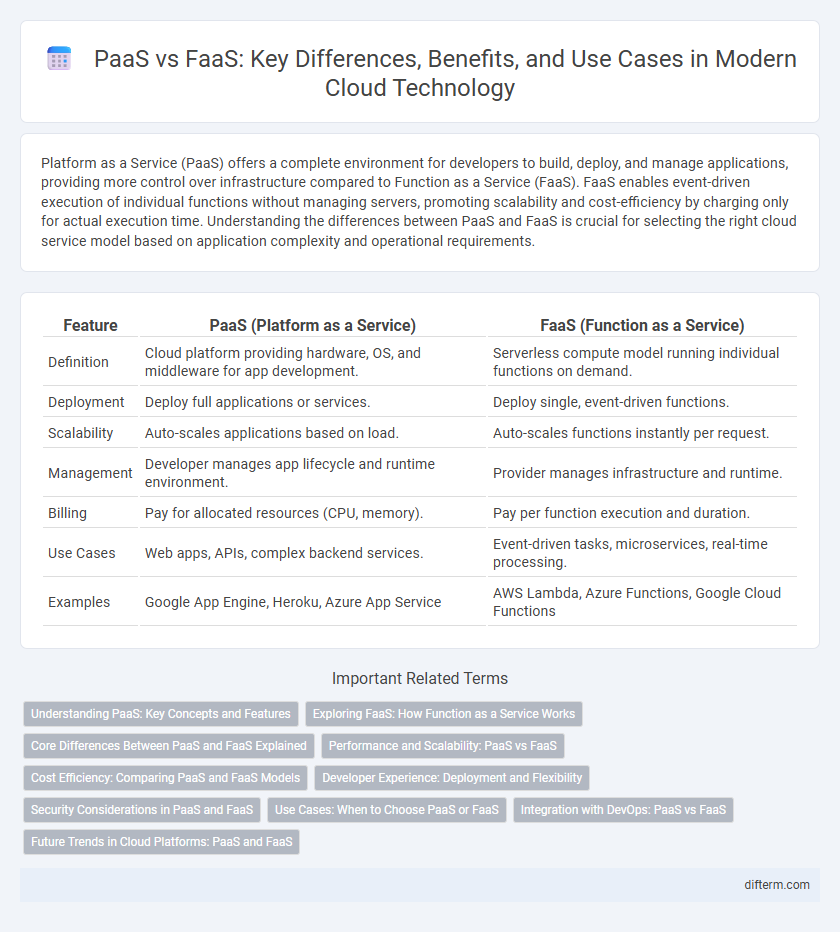Platform as a Service (PaaS) offers a complete environment for developers to build, deploy, and manage applications, providing more control over infrastructure compared to Function as a Service (FaaS). FaaS enables event-driven execution of individual functions without managing servers, promoting scalability and cost-efficiency by charging only for actual execution time. Understanding the differences between PaaS and FaaS is crucial for selecting the right cloud service model based on application complexity and operational requirements.
Table of Comparison
| Feature | PaaS (Platform as a Service) | FaaS (Function as a Service) |
|---|---|---|
| Definition | Cloud platform providing hardware, OS, and middleware for app development. | Serverless compute model running individual functions on demand. |
| Deployment | Deploy full applications or services. | Deploy single, event-driven functions. |
| Scalability | Auto-scales applications based on load. | Auto-scales functions instantly per request. |
| Management | Developer manages app lifecycle and runtime environment. | Provider manages infrastructure and runtime. |
| Billing | Pay for allocated resources (CPU, memory). | Pay per function execution and duration. |
| Use Cases | Web apps, APIs, complex backend services. | Event-driven tasks, microservices, real-time processing. |
| Examples | Google App Engine, Heroku, Azure App Service | AWS Lambda, Azure Functions, Google Cloud Functions |
Understanding PaaS: Key Concepts and Features
Platform as a Service (PaaS) delivers a comprehensive development environment that includes infrastructure, middleware, and tools to build, test, and deploy applications efficiently. Core features of PaaS encompass automated scaling, integrated development environments (IDEs), and support for multiple programming languages, enabling streamlined application lifecycle management. PaaS simplifies infrastructure management by providing pre-configured environments, reducing the need for manual setup and accelerating time-to-market for cloud-based applications.
Exploring FaaS: How Function as a Service Works
Function as a Service (FaaS) enables developers to deploy individual functions that execute in response to events without managing underlying servers, offering scalable and cost-effective computing. This event-driven architecture allows automatic scaling based on demand, reducing infrastructure overhead compared to traditional Platform as a Service (PaaS) models. Popular FaaS platforms like AWS Lambda, Azure Functions, and Google Cloud Functions support seamless integration with cloud services, streamlining microservice development and enhancing application agility.
Core Differences Between PaaS and FaaS Explained
PaaS (Platform as a Service) offers a full development environment with tools, libraries, and runtime environments to build, deploy, and manage applications, while FaaS (Function as a Service) focuses on executing discrete functions in response to events without managing servers. PaaS requires developers to manage application scaling and infrastructure configuration, whereas FaaS automatically handles scaling and resource allocation at the function level. Core differences include PaaS's broader control over the application lifecycle versus FaaS's event-driven, micro-billing model optimized for short-lived, stateless functions.
Performance and Scalability: PaaS vs FaaS
PaaS offers robust performance with dedicated resources and scalability through pre-configured environments, ideal for steady workloads and long-running applications. FaaS excels in automatic scaling and resource optimization by executing code in response to events, reducing latency and operational costs for unpredictable or variable workloads. Both models enhance application performance but differ in scalability mechanics: PaaS scales at the infrastructure level, whereas FaaS scales at the function invocation level.
Cost Efficiency: Comparing PaaS and FaaS Models
PaaS offers predictable monthly costs ideal for steady workloads, while FaaS employs a pay-as-you-go model charging only for actual execution time, enhancing cost efficiency for variable or intermittent traffic. FaaS minimizes idle resource expenses by automatically scaling down during inactivity, reducing overhead compared to PaaS's continuous resource allocation. Enterprises with fluctuating demand benefit from FaaS's granular pricing, whereas consistent workloads may find PaaS more economical due to fixed pricing structures.
Developer Experience: Deployment and Flexibility
PaaS offers developers a streamlined deployment process with dedicated environments that support continuous integration and customizable configurations, enabling greater control over application management. FaaS emphasizes rapid deployment through event-driven functions that auto-scale without server management, enhancing flexibility for microservices and transient workloads. The choice impacts developer experience by balancing control and simplicity, where PaaS suits persistent applications and FaaS excels in agile, event-based execution.
Security Considerations in PaaS and FaaS
PaaS security considerations involve managing application-level vulnerabilities, data protection, and securing the underlying platform provided by the vendor, including access controls and patch management. FaaS security focuses on event-driven function isolation, minimizing attack surfaces through ephemeral execution environments, and securing API gateways to prevent unauthorized invocations. Both models require robust identity and access management (IAM) policies and continuous monitoring to ensure compliance and detect potential threats.
Use Cases: When to Choose PaaS or FaaS
PaaS is ideal for developing complex applications requiring full control over the runtime environment, such as enterprise-grade web apps or APIs that need consistent performance and integrated development tools. FaaS excels in event-driven architectures where scalable, cost-effective execution of discrete functions is necessary, such as real-time data processing, IoT event handling, or microservices that handle unpredictable traffic. Selecting between PaaS and FaaS depends on the application's architecture, scalability needs, and developer control preferences.
Integration with DevOps: PaaS vs FaaS
PaaS platforms streamline DevOps workflows by providing pre-configured environments that support continuous integration and continuous deployment (CI/CD) pipelines, facilitating faster application development and testing. FaaS enhances DevOps integration by enabling event-driven functions that scale automatically without server management, reducing deployment complexity and operational overhead. Both PaaS and FaaS improve collaboration between development and operations teams, but FaaS offers finer-grained scalability and cost efficiency for microservice-oriented architectures.
Future Trends in Cloud Platforms: PaaS and FaaS
Future trends in cloud platforms indicate rapid growth in both PaaS and FaaS adoption, driven by the need for scalable, cost-efficient solutions in application development and deployment. PaaS platforms are evolving to offer enhanced integration with AI and machine learning services, while FaaS is expanding its capabilities in event-driven computing and serverless orchestration. Enterprises increasingly leverage hybrid models combining PaaS and FaaS to optimize performance, reduce operational overhead, and accelerate innovation in cloud-native ecosystems.
PaaS vs FaaS Infographic

 difterm.com
difterm.com